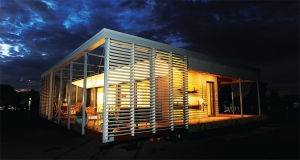Solar Decathlon
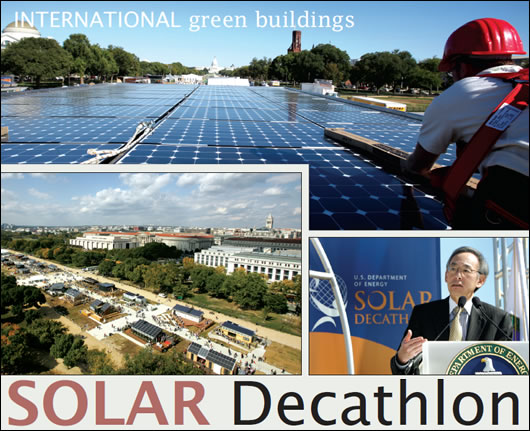
Lenny Antonelli takes a look at some of the entrants of the 2009 Solar Decathlon, a competition that challenges university teams from around the world to design and build homes that capture the sun’s energy
Energy from the sun is virtually limitless – the only problem is capturing it. That’s the task posed by the Solar Decathlon, a competition that challenges university teams from around the world to design and build homes that capture the sun’s energy.
From a solar roof that tilts and turns to follow the sun to a house made from grain silos, the diversity of designs here is striking. Teams must build modern, architecturally appealing houses that harness solar energy actively and passively, using the sun to produce electricity (with photovoltaic panels and thin-film arrays) and heat (using solar thermal panels and passive solar design).
Held in Washington DC every two years, the 2009 Solar Decathlon attracted over 200,000 visitors. “Homes and other buildings account for 40 per cent of the energy we use in the United States,” says US energy secretary Steven Chu. “There is an incredible opportunity to design and construct living and work spaces that are dramatically more efficient than those we build today. Competitions like this one can lead to new solutions and inspire a new generation of problem solvers.”
Competing teams are rewarded for their house’s performance in a variety of categories, including architecture, market viability, engineering, lighting and water heating. The most important category is net metering, which measures how much net electricity the houses produce over the week of the competition. Many of the homes feature innovative synthetic insulations and sophisticated energy management systems. Some are probably a little too gadget-heavy for green purists, but there were still plenty of ideas and innovations here worth reading about.
The categories
Architecture (100 points): Houses are assessed on three main factors: architectural elements, holistic design, and inspiration. Teams are rewarded for integrating solar and energy-efficiency technologies seamlessly into their design.
Market viability (100 points): Teams must choose a target market and prove their house can be affordable within it. Houses are judged based on how suitable they are for everyday living, how practical they are to build and whether they offer good value for money.
Engineering (100 points): A jury of engineers evaluates each house’s energy systems for functionality, efficiency, innovation, and reliability.
Lighting design (75 points): Teams earn points in this contest with functional, energy-efficient, easy-to-use and stylish lighting systems. House designs that make ample use of natural light are also rewarded.
Communications (75 points): Teams must communicate the technical aspects of their houses and their experience in the competition to a wide audience. Teams are marked based on the quality of their websites, communication plans, house tours and their ability to engage visitors.
Comfort zone (100 points): The challenge here is to maintain comfortable conditions in the house throughout the competition – teams receive full points for maintaining narrow ranges of temperature (22.2 – 24.4°C) and relative humidity (40–55 per cent).
Hot water (100 points): Teams must demonstrate their solar thermal systems can supply all the hot water used for washing and bathing. They score points in this contest by proving their solar systems can deliver 68 litres of hot water in ten minutes.
Appliances (100 points): Teams have to mimic the appliance use of the average US home but using less energy. During the contest they must maintain refrigerator and freezer temperatures within typical ranges, wash and dry 10 loads of laundry, and run the dishwasher five times.
Home entertainment (100 points): This category is designed to show that houses powered solely by the sun can deliver more than just basic functionality, and to prove that they can run modern electronics, appliances and other conveniences.
Net metering (150 points): Each house is equipped with a meter that measures how much net energy the house produces or consumes over the course of the competition. Teams score points for producing as much or more energy than they consume.
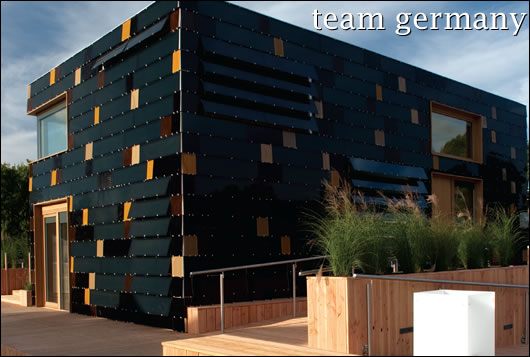
Winners in 2007, Team Germany were victorious again in 2009 with their striking surPLUS house. The team wrapped the house in solar technology and claim it can produce up to twice its own electricity demand.
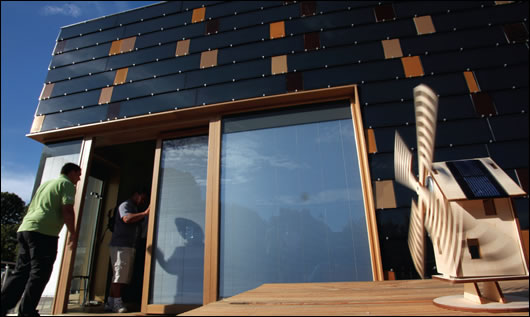
An 11 kW silicon photovoltaic (PV) array blankets the roof, while the walls are clad with thin-film copper indium gallium diselenide (CIGS) panels. CIGS aren't quite as efficient as PV panels, but they're more effective in cloudier weather and cheaper to produce. Key to Team Germany's victory was its success in the net metering category – teams that took no net energy from the grid over the week were awarded 100 points, but by exporting so much surplus electricity the Germans were awarded an extra 50 points too. They also scored highly in the architecture, comfort and hot water categories.
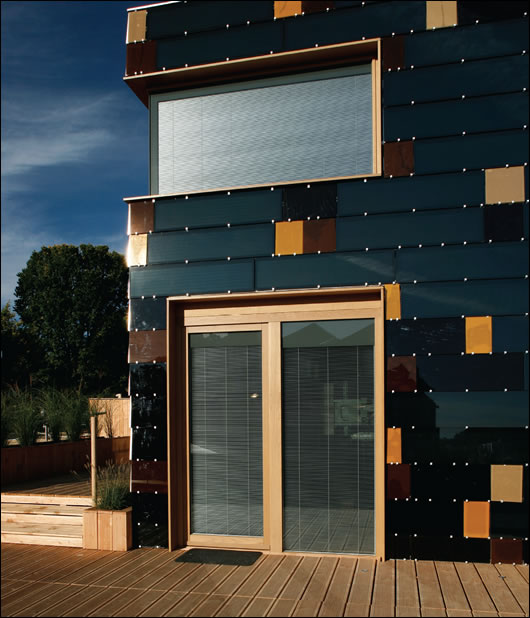
The team wanted their timber-frame house to use as little energy as possible: its high performance vacuum insulation panels and triple glazed windows giving it a heat demand of just 14.9 kWh/m2/yr. An air source heat-pump can heat and cool the house, while phase change materials in the walls (paraffin) and the roof (salt hydrate) balance temperatures inside by absorbing heat, then melting and releasing it slowly as they cool down and solidify. A small group of 24 – mostly architecture students – designed the house, though plenty of others helped out too. "Even my boyfriend, all the families and friends got involved," says team member Sardika.
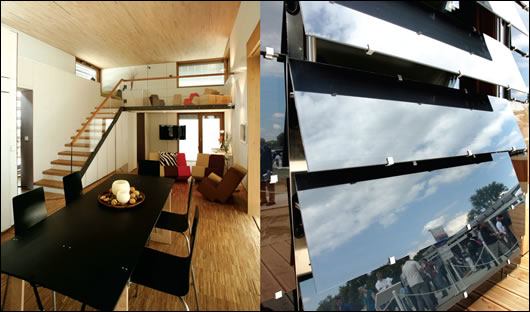
(left) glass balustrades internally reduce electrical lighting requirements; (right) people are reflected on Team Germany's window louvers, which feature integrated CIGS modules
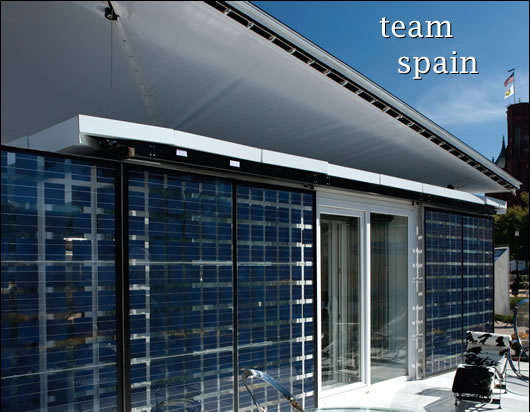
Having entered more conventional homes in the Solar Decathlon in 2005 and 2007, the Spanish team felt it had to "do something completely different" in 2009. And it certainly did – their house’s roof features an inverted pyramid with an 11kW solar array on top that tilts and turns on a ball and socket to follow the sun.
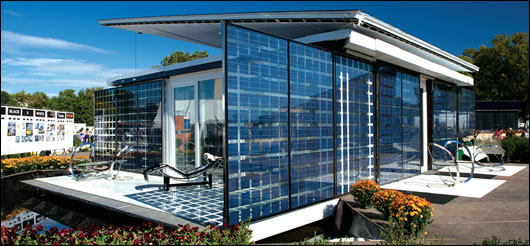
Team Spain’s house features a solar PV facade that can move to follow the sun, while the house’s roof is topped by an inverted pyramid with an 11kW solar PV that tilts and turns to follow the sun
This improves the system’s efficiency by 10 per cent compared to a conventional south-facing array, the team says. The designers clad the walls with solar panels too – both PV and solar thermal – and just like the roof, the solar facade can move to follow sunlight. Team Spain estimates the house will produce over 19,000 kWh of electricity a year.
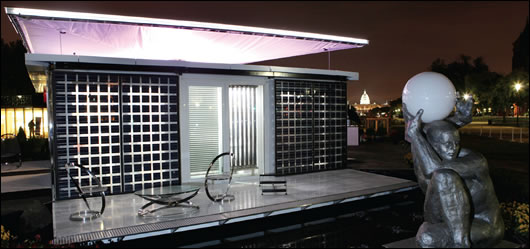
The team’s solar-powered home glows at night during the lighting contest
Built with a steel frame and structurally insulated panels (SIPs), the house is designed to be easy to take apart, move and expand. A ground source heat pump both heats and cools inside, while a sun room captures solar heat and light passively. Windows behind the transparent solar facade let sunlight in too, and LEDs provide artificial light when needed. The house scored over 100 points in the net metering category, meaning that it produced more electricity than it used. Team Spain are certainly confident in the uniqueness of their design – they've filed patent applications for the solar roof, the ball and socket that drives it and their moving solar facade.
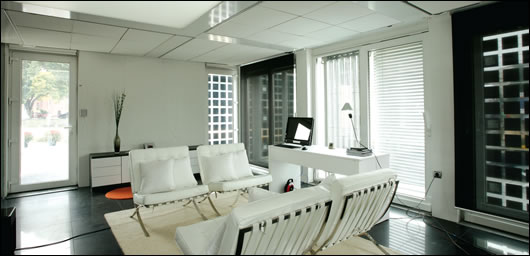
windows behind the transparent solar façade are designed to let sunlight in
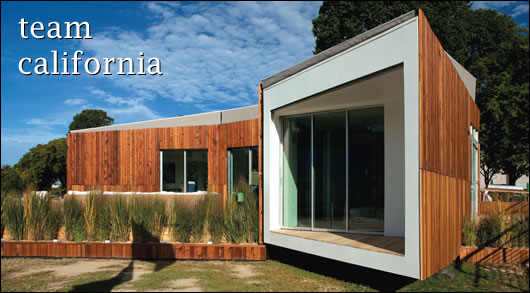
Getting as much passive energy as possible from the sun was the goal for Team California, who clearly built with their home state in mind. Their curved design maximises south-facing glazing – with low-e glass, and argon and krypton fill – to capture the sun’s light and heat. "The beauty of California comes through in this design and the use of windows," says team member Allison Kopf. Active solar technology is used too: a solar thermal absorption chiller cools the house while providing waste energy to pre-heat water, while an 8kW photovoltaic array on the roof generates electricity. A smartphone application allows users to monitor the house's performance and to adjust heating and lighting remotely.
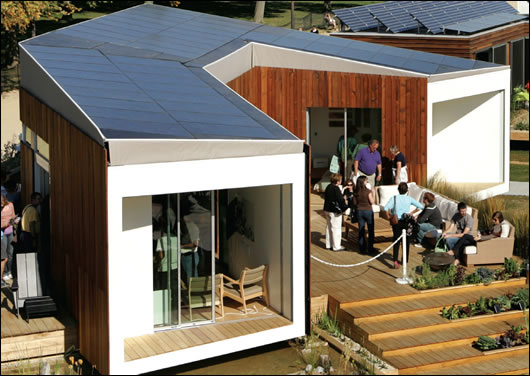
An 8kW solar PV array on the roof generates electricity
Insulated with both vegetable-based spray foam and recycled denim, the steel-framed house boasts plenty of other green features: reclaimed redwood timber and salvaged billboards clad the outside, while fast growing bamboo is used for the roof joists. LEDs lights were installed throughout too, and rainwater is collected for gardening. California finished third and scored highly in a variety of categories including market viability, engineering and hot water, and won the architecture award. To increase a sense of space, the house's patio is a key part of the design. "During the summer you can leave the doors open and your 800 square foot house because much larger," says team member Timothy Sennett.
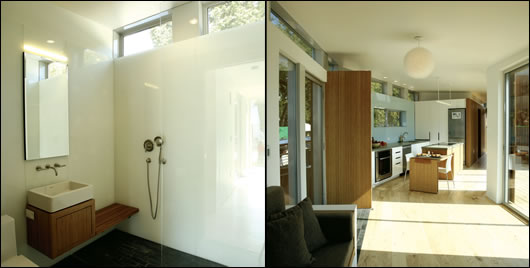
The interior of the steel-framed house is cooled by a solar absorption chiller
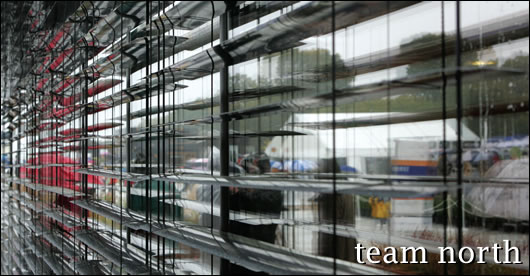
The team from three Canadian universities aimed to build something truly testing – a passive solar house suitable for a cold climate. “Contemporary wisdom is that buildings in a northern climate need to have thick insulated walls with a low rate of window to wall,” project architect Chris Black says. “One of the starting points of the design of North House was to turn this convention on its head, and to look at how we could get a building with a 75 per cent plus glass ratio.”
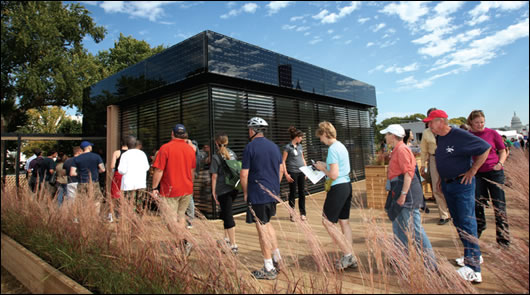
The house features wall-to-roof quadruple glazing wrapped in a shading textile that occupants can control or that can be automated to respond to changing conditions outside
The house features wall-to-roof glazing on three sides - the idea was to maximize passive gains from the low-angle northern sun. The team chose quadruple glazing (two glass layers sandwiching two layers of mylar, a type of insulating polyester film) with an astonishing U-value of 0.44 W/m2K. They also wrapped the house in a shading textile – occupants can opt for full solar penetration, complete shading or a setting somewhere in between. The main site of heat loss – the northern wall – is heavily insulated, and the team paid detailed attention to air-tightness.
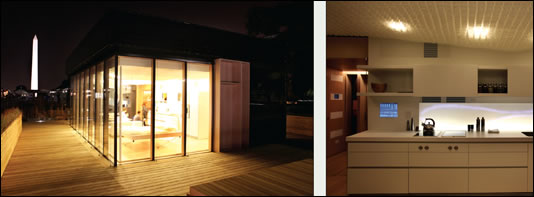
The North House boasts over 11kW of PV, while solar evacuated tubes provide hot water and heat recovery ventilation features too. Team North finished fourth overall, scoring highly in the communications, comfort and hot water categories. Their best finish was in net metering – the house produced more electricity than it consumed over the week. Such a high tech home didn’t come cheap though, costing more than $850,000 to build. And though it performed well in the competition – held in Washington DC in October – it’s still not entirely clear how well it will do through a Canadian winter.
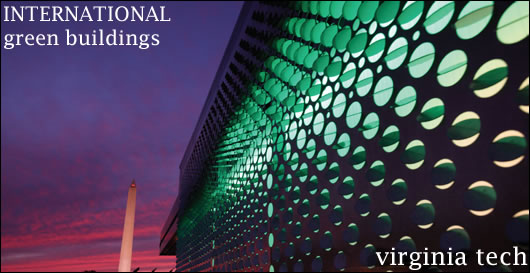
It’s no surprise that Virginia Tech’s best finish was in the architecture category – the team’s home is inspired by Bauhaus architect Ludwig Mies van der Rohe’s famous Farnsworth House. And as with the Mies house, natural light was the key design theme for the Virginia team. Built for the hot Virginia climate, the house is built with clear polycarbonate panels filled with aerogel, a translucent high performance insulator that allows sunlight into the house. Metal shutter shades prevent overheating and glare when needed, and the insulating panels can be pulled back in good weather to extend the floor area to the patio outside. A 9kW PV array on the roof provides power, and a ground source heat pump features too.
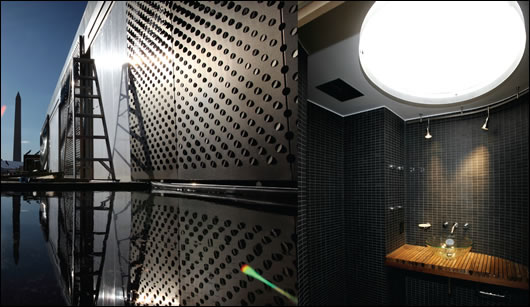
(left) Sun screens and a grey water filtration system at the house reflect sunlight, (right) a sun tube brings natural light into the deep-plan bathroom
The house is equipped with a weather station that monitors temperature, wind speed, humidity and daylight, and the whole house’s shading, lighting and heating systems can be programmed to respond automatically to changing conditions or controlled manually Though it might appear a bit too high tech for some, important green materials do feature: recycled fly ash in the concrete floor and properly sourced timber in the decking outside for example. Virginia Tech finished 13th overall, coming third in the architecture category, fifth in engineering and eighth in net metering. Their house will now enter the Solar Decathlon Europe in Madrid this summer.

The sliding metal shutter shades can be used to protect the house from glare and over heating or pulled back to let sunlight in fully
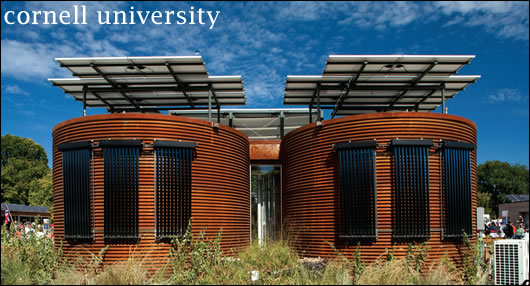
Cornell’s silo house is certainly the oddest to feature in the Solar Decathlon. Comprised of three interconnected steel silos, it’s designed to fit neatly in the agricultural landscape of upstate New York. Each silo houses a different room – kitchen, sitting room, bedroom – and has just 12 square metres of floor area. An 8kW solar PV array generates electricity, while a solar evacuated tube system heats water. Occupants can monitor energy production and consumption with a smart meter that also gives them sophisticated control over energy use, allowing appliances to switch on or off automatically based on real-time energy prices.
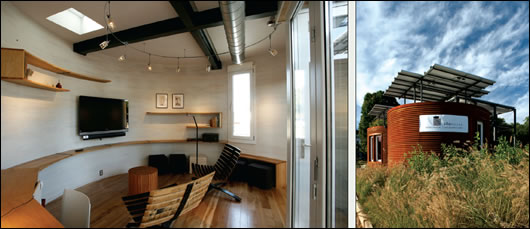
Two skylights allow natural light into each silo, and the house is insulated with aerogel blocks. Rainwater is collected on the roof and used to water the garden, which is divided into three zones: a greywater filtration area, a low maintenance zone and a meadow. Cornell finished seventh overall and third in the people’s choice award. “Building round was a challenge – building something so unconventional meant no dull moments – everyone wanted to see how our gamble would play out,” Chris Werner wrote on the team’s blog. “And though it didn’t equate to points, we became the iconic image of Solar Decathlon media coverage, we ranked third in people’s choice, and we received the kudos of fellow Decathletes for being so bold.”
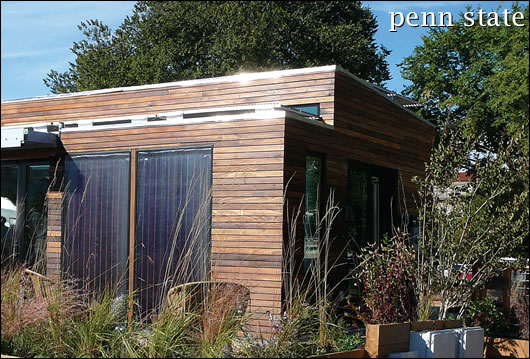
Overheating reduces the efficiency of solar PV, but the Penn State team found a clever solution – a solar-integrated green roof. By installing an elevated array of cutting edge PV tubes sunlight can reach the green roof beneath, allowing evaporation from the plants to cool the tubes above and improve their efficiency. “The great thing about a tube is that no matter where the sun is in the sky, you always have perpendicular direct solar radiation to the tube,” team leader Kyle Macht told Treehugger.com. “You’re collecting a lot more energy in the morning and evening than a typical solar array.”
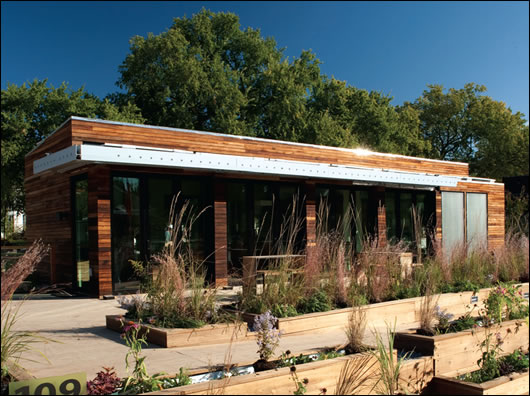
The south facade can be fully opened up in summer to merge the interior with the decking outside
The team’s timber-frame home uses a pump-less – and therefore electricity free – wall mounted solar thermal system too, and passive solar energy too: the south face is extensively glazed and features an automated shading system that tracks the sun. The south facade can be fully opened in summer to merge the outdoor decking with the inside. Integrating outside and inside is a big design theme here: green walls are present inside and out, and wildlife and vegetable gardens also feature.
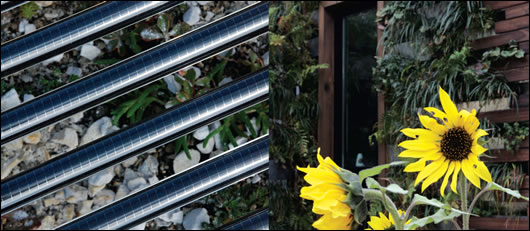
By installing an elevated array of solar PV tubes sunlight can reach the green roof beneath; (right) greens walls clad the house both outside and inside
Phase change materials in the walls help to balance temperature by absorbing heat and releasing it slowly, while Biobased spray foam insulates the walls. Flat plate panels heat water, while “water bladders” – essentially water filled bags under the floor – provide thermal mass. Various other green materials also feature: sustainably harvested timber, reclaimed chalkboards, salvaged hardwood flooring and VOC free paints. The Penn State team finished 16th, coming third in the engineering category and fourth in lighting design.


